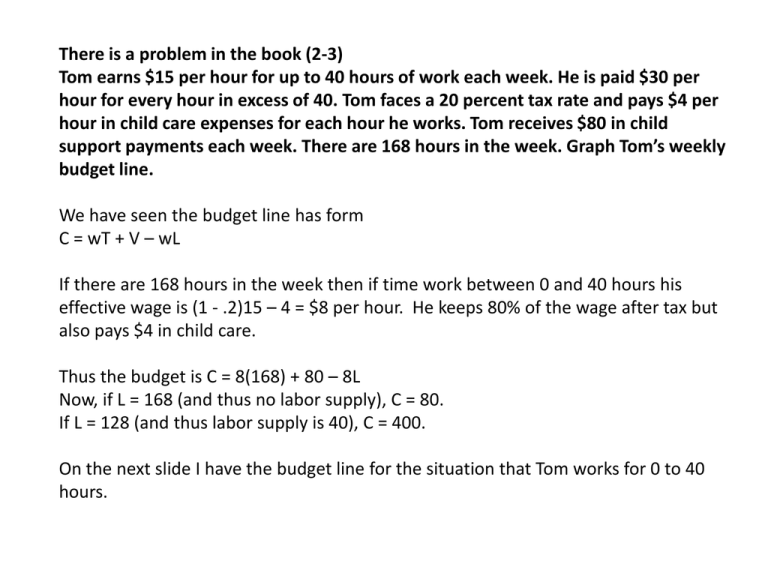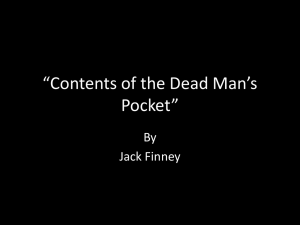Assignment 3
advertisement

There is a problem in the book (2-3) Tom earns $15 per hour for up to 40 hours of work each week. He is paid $30 per hour for every hour in excess of 40. Tom faces a 20 percent tax rate and pays $4 per hour in child care expenses for each hour he works. Tom receives $80 in child support payments each week. There are 168 hours in the week. Graph Tom’s weekly budget line. We have seen the budget line has form C = wT + V – wL If there are 168 hours in the week then if time work between 0 and 40 hours his effective wage is (1 - .2)15 – 4 = $8 per hour. He keeps 80% of the wage after tax but also pays $4 in child care. Thus the budget is C = 8(168) + 80 – 8L Now, if L = 168 (and thus no labor supply), C = 80. If L = 128 (and thus labor supply is 40), C = 400. On the next slide I have the budget line for the situation that Tom works for 0 to 40 hours. C My scale is a little off here 400 80 L 128 168 Now, if tome works all 40 hours he will have $8 an hour for a total of $320. If he works more hours he will always have this $320 from his first 40 hours. In this sense we can think of the $320 as nonlabor income when he works more than 40 hours. His new effective wage = (1 - .2)30 – 4 = 20 and his budget line has the form C = 20(168-40) + 320 + 80 – 20L = 20(128) + 400 – 20L = 2960 – 20L. Now, if L = 128, C = 400, and If L = 127 (and work is 41 hours), C = 2960 – 20(127) = 420. If L = 0, C = 2960. I have added these new points to the graph. See this on the next slide. C This intercept point is (0, 2960) This “kinked” point is (128, 400) 420 My scale is a little off here Techically this endowment point is (168, 80) 400 80 L 127 128 168 So, if T is total time, w is the initial (effective) wage and w’ is the alternative wage with overtime, the budget at the endowment (all leisure) to the maximum hours of work at the original wage is C = wT + V – wL. The budget with overtime is C = w’(T – 40) + w40 + 80 – w’L. For a 5 point homework take the problem and change the $ amounts in the following way. Tom earns $30 per hour for up to 40 hours of work each week. He is paid $60 per hour for every hour in excess of 40. Tom faces a 20 percent tax rate and pays $8 per hour in child care expenses for each hour he works. Tom receives $160 in child support payments each week. There are 168 hours in the week. Graph Tom’s weekly budget line. You do not have to show me the graph. Just tell me the values of the endowment point, the kinked point and the intercept. If you can do this then you can do the graph.











